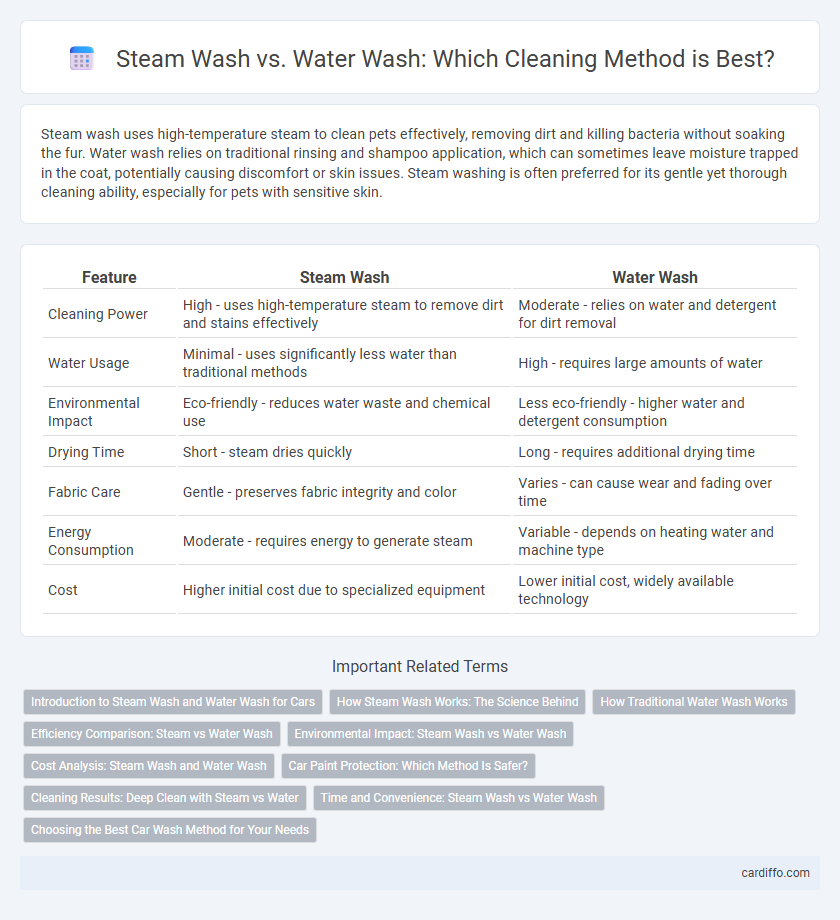Steam wash uses high-temperature steam to clean pets effectively, removing dirt and killing bacteria without soaking the fur. Water wash relies on traditional rinsing and shampoo application, which can sometimes leave moisture trapped in the coat, potentially causing discomfort or skin issues. Steam washing is often preferred for its gentle yet thorough cleaning ability, especially for pets with sensitive skin.
Table of Comparison
| Feature | Steam Wash | Water Wash |
|---|---|---|
| Cleaning Power | High - uses high-temperature steam to remove dirt and stains effectively | Moderate - relies on water and detergent for dirt removal |
| Water Usage | Minimal - uses significantly less water than traditional methods | High - requires large amounts of water |
| Environmental Impact | Eco-friendly - reduces water waste and chemical use | Less eco-friendly - higher water and detergent consumption |
| Drying Time | Short - steam dries quickly | Long - requires additional drying time |
| Fabric Care | Gentle - preserves fabric integrity and color | Varies - can cause wear and fading over time |
| Energy Consumption | Moderate - requires energy to generate steam | Variable - depends on heating water and machine type |
| Cost | Higher initial cost due to specialized equipment | Lower initial cost, widely available technology |
Introduction to Steam Wash and Water Wash for Cars
Steam wash for cars uses high-temperature steam to clean surfaces effectively while conserving water and reducing chemical use. Water wash relies on traditional methods with water jets and detergents to remove dirt and grime but consumes significantly more water. Steam washing offers an eco-friendly alternative, minimizing water waste and enhancing sanitation without compromising cleaning power.
How Steam Wash Works: The Science Behind
Steam wash uses high-temperature steam jets to penetrate fabric fibers, effectively loosening dirt and killing bacteria without the need for harsh chemicals. Water wash relies on mechanical agitation and detergent to remove soil from clothing, but steam's heat and moisture provide a deeper cleaning by loosening grime at the molecular level. This method conserves water and energy while enhancing fabric care through precise temperature control and condensation effects.
How Traditional Water Wash Works
Traditional water wash relies on water as the primary cleaning agent, using mechanical agitation to loosen and remove dirt from fabrics. The process typically involves soaking, scrubbing, and rinsing cycles where water dissolves and flushes away contaminants. This method is energy-intensive due to heating water and requires substantial water consumption, impacting both operational costs and environmental footprint.
Efficiency Comparison: Steam vs Water Wash
Steam wash uses high-temperature vapor to penetrate fabrics, effectively removing dirt and bacteria with significantly less water consumption than traditional water wash. Water wash relies on large volumes of water and detergent, resulting in longer cycle times and higher energy usage for heating and agitation. Steam wash offers improved efficiency by reducing water waste, shortening washing cycles, and lowering energy costs in commercial and residential laundry applications.
Environmental Impact: Steam Wash vs Water Wash
Steam wash significantly reduces water consumption by using high-temperature steam to clean surfaces, minimizing the environmental footprint associated with traditional water wash methods. It decreases the release of harmful detergents and chemicals into wastewater systems, promoting cleaner water ecosystems. Energy-efficient steam technologies also lower greenhouse gas emissions compared to the extensive water treatment and heating needed in conventional water washing processes.
Cost Analysis: Steam Wash and Water Wash
Steam wash systems generally incur higher initial installation costs due to advanced equipment requirements, but they offer significant long-term savings by reducing water and energy consumption. Water wash methods have lower upfront expenses but lead to increased operational costs from higher water usage, wastewater treatment, and extended drying times. Evaluating total cost of ownership, steam wash proves more cost-effective for businesses aiming to minimize resource consumption and utility bills over time.
Car Paint Protection: Which Method Is Safer?
Steam wash uses high-temperature vapor that gently lifts dirt without abrasive scrubbing, significantly reducing the risk of paint scratches and preserving the car's clear coat. Water wash, while effective at removing grime, can sometimes introduce fine particles or rely on harsh chemicals that may gradually erode or dull the paint surface. Therefore, steam washing is generally considered safer for maintaining the integrity and shine of automotive paint.
Cleaning Results: Deep Clean with Steam vs Water
Steam wash delivers a deep clean by penetrating fabric fibers with high-temperature steam, effectively breaking down dirt, grease, and bacteria that water alone may not remove. Water wash relies on detergent and mechanical agitation but may leave residues and struggle with tough stains. Steam's ability to sanitize and refresh garments without harsh chemicals provides superior cleaning results compared to traditional water washing methods.
Time and Convenience: Steam Wash vs Water Wash
Steam wash significantly reduces cleaning time by penetrating fabrics rapidly and loosening dirt with minimal water usage, offering a more convenient option for busy schedules. Water wash generally takes longer due to the need for soaking, rinsing, and multiple cycles, which can be less efficient for quick laundry tasks. Choosing steam wash increases convenience by combining speed and effective cleaning while consuming less water and energy.
Choosing the Best Car Wash Method for Your Needs
Steam wash uses high-temperature vapor to clean vehicles, effectively removing dirt and grime while conserving water, making it an eco-friendly choice for those seeking sustainability. Water wash relies on pressurized water jets, often combined with detergents, providing a thorough clean suitable for heavy-duty dirt but consuming more water. Selecting between steam wash and water wash depends on factors like environmental impact, cleaning intensity, and the vehicle's surface sensitivity.
Steam Wash vs Water Wash Infographic

 cardiffo.com
cardiffo.com